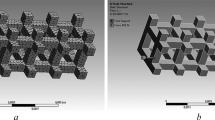Abstract
The aim of this study is to establish the dependence of the mechanical strength of products with the geometry of the Schwarz P-surface on the number and size of unit cells. The products are manufactured using selective laser sintering on an EOS Formiga P110 3D printer made of polyamide-12. A Grasshopper script is developed to simulate the samples. Grasshopper is the visual programming language integrated into the Rhinoceros 3D CAD program. The manufactured samples have the same dimensions (inscribed in cubes with dimension of 60 × 60 × 60 mm) and the same degree of space filling. The nature of the fracture and the areas in which the maximum stresses accumulate in the samples are established using the finite element method in the Comsol Multiphysics program. A hypothesis is put forward, according to which, with an increase in the number of unit cells, the specific strength of the samples increases, and a mathematical model is proposed that describes this phenomenon. The mechanical tests confirm this hypothesis.





Similar content being viewed by others
REFERENCES
Schwarz, H.A., Gesammelte Mathematische Abhandlungen, Berlin: Springer, 1933.
Shahrubudin, N., Lee, T.C., and Ramlan, R., An overview on 3D printing technology: Technological, materials, and applications, Proc. Manuf., 2019, vol. 35, pp. 1286–1296.
Abueidda, D.W., Elhebeary, M., Shiang, C.S., Pang, S., and Abu Al-Rub, R.K., Mechanical properties of 3D printed polymeric gyroid cellular structures: Experimental and finite element study, Mater. Des., 2019, vol. 165, no. 107597.
Shevchenko, V.Ya., Sychev, M.M., Lapshin, A.E., and Lebedev, L.A., Ceramic materials with the triply periodic minimal surface for constructions functioning under conditions of extreme loads, Glass Phys. Chem., 2017, vol. 43, no. 6, pp. 605–607.
Zienkiewicz, O.C., The Finite Element Method in Engineering Science, 2nd ed., New York: McGraw-Hill, 1971.
Wolfgang, G. and Djavid, R., Nylon 12: Preparation, properties, and applications, Ind. Eng. Chem., 1970, vol. 62, pp. 16–22.
ISO 604:2002, Plastics. The technique of compressive strength measurements, MOD.
Sychev, M.M., Lebedev, L.A., Dyachenko, S.V., and Nefedova, L.A., Mechanical properties of energy-absorbing structures with triply periodic minimal surface topology, Acta Astronaut., 2018, vol. 150, pp. 81–84.
Funding
The study of the mechanical properties of structures and the development of topologies was financially supported by the Russian Science Foundation (project no. 20-73-10171). The development of a technique for modeling mechanical properties was carried out as part of a state assignment of the Institute of Chemistry of the Russian Academy of Sciences (state registration number of the topic, AAAA-A19-119022290092-5).
Author information
Authors and Affiliations
Corresponding author
Ethics declarations
The authors declare that they have no conflict of interest.
Rights and permissions
About this article
Cite this article
Makogon, A.I., Balabanov, S.V. & Sychev, M.M. The Influence of the Size of the Unit Cell on the Physical and Mechanical Properties of Samples with the Schwartz Primitive Topology. Glass Phys Chem 47, 505–507 (2021). https://doi.org/10.1134/S1087659621050102
Received:
Revised:
Accepted:
Published:
Issue Date:
DOI: https://doi.org/10.1134/S1087659621050102




